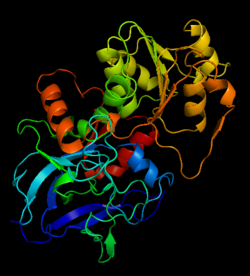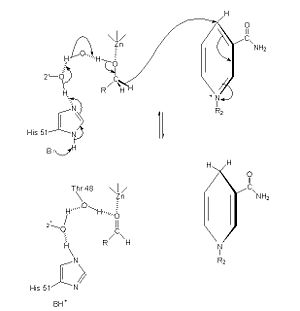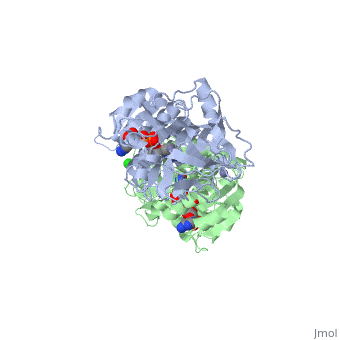
Structure of Alcohol Dehydrogenase
Function
Alcohol dehydrogenase (ADH, EC number 1.1.1.1) is an 80kDa enzyme that catalyzes the 4th step in the metabolism of fructose before glycolysis. In the 4th step, glyceraldehyde is converted to the glycolytic intermediate DHAP by the NADH-dependent, ADH catalyzed reduction to glycerol.[1] ADH catalyzes the oxidation of primary and secondary alcohols to their corresponding aldehydes and ketones through a mechanism that involves the removal of a hydrogen. More detailed discussions in
Hydroxyacyl-CoA dehydrogenase (HADH) catalyzes the conversion of 3-hydroxyacyl-CoA to 3-oxoacyl-CoA. NAD is the cofactor of HADH activity. HADH oxidates straight-chain 3-hydroxyacyl-CoAs in the β-oxidation pathway of fatty acid metabolism. HADH is classified according to its substrate ads short chain (SHCDH) and long chain HADH. HADH deficiency is a genetic disorder.
alcohol dehydrogenase I, II, III, IV differ by their tissue specificity.
Secondary alcohol dehydrogenase catalyses the reduction of acetone to isopropanol[2].
NADP-dependent alcohol dehydrogenase catalyses the redox equilibria between aldehydes or ketones and the corresponding primary or secondary alcohols [3].
Quinone-dependent alcohol dehydrogenase oxidizes primary, secondary alcohols, aldehydes, polysaccharides and cyclodextrins [4].
Quinohemoprotein alcohol dehydrogenase have pyrroloquinoline quinone (PQQ) as the prosthetic group [5].
For chimeras of alcohol dehydrogenase see
The of overall Cα backbone of all these chimeras (rmsd 0.45-0.65 Å) with those of the parent enzymes, did not reveal significant structural changes. So, the differences in the thermal stability of the chimeras and the parent enzymes could be caused by relatively small specific changes located at the important points of the NADP+-dependent alcohol dehydrogenases. For example see Cα superposition for the X23(TET) chimera (red) (3fpc) and its parent ADHs (TbADH, colored blue (1ped), and EhADH1, colored green (1y9a). The RMSDs of the TbADH−EhADH1, TbADH−Χ23(TET), and EhADH1−Χ23(TET) were 0.68, 0.56, and 0.48 Å, respectively.
Reaction and Mechanism
In the oxidation mechanism, ADH is momentarily associated with nicontinamide adenine dinucleotide (NAD+), which functions as a cosubstrate. In its reaction, alcohol dehydrogenase uses zinc and NAD to facilitate the reaction. The function of zinc is to position the –OH group on the ethanol in a conformation that allows for the oxidation to occur. NAD then acts as a cosubstrate and performs the oxidation.

The of alcohol dehydrogenase reaction is as follows: CH3CH2OH + NAD+ -> CH3COH (acetaldehyde) + NADH + H+ (Note: The reaction is actually reversible although the arrow does not show it) [6] The step-wise reduction mechanism for ADH is shown on the left. In the mechanism, His 51 is deprotonated and activated by a base catalyst. This allows histidine to accept a proton from NAD, which also draws a proton Thr 48. As a result of the proton transfer, the Thr is prepared to accept a proton from the alcohol substrate. While Thr accepts the proton, there is also a hydride transfer to NAD. The whole process can be summarized as the oxidation of an alcohol to an aldehyde in concert with the transfer of a hydride to NAD.[7][8]
The Mechanism for alcohol dehydrogenase follows an random bisubstrate mechanism.[9] In the mechanism, the NAD+ and alcohol bind to the enzyme, so that the enzyme is now attached to the two subtrates. While attached, the hydrogen is formally transferred from the alcohol to NAD, resulting in the products NADH and a ketone or aldehyde. The two products are then released, and the enzyme has catalyzed the reaction.
Kinetics
The alcohol dehydrogenase catalyzed aldehyde-NADH reaction show kinetics consistent with a random-order mechanism, and the rate-limiting step is the dissociation of the product enzyme-NAD+ complex. [10] Alcohol dehydrogenase is more effective for smaller alcohol substrates, and it becomes less effective as substrate size increases. It is also more effective for primary than secondary alcohols.[11] In a study where ADH was immobilized in tresyl-chloride-activate agarose, it was shown that the Michaelis-Menten model could not take into consideration all the constraints induced by the immobilization on the enzyme properties but that the Theorell-Chance model was more appropriate.[12]
Regulation
Substrate size is a regulator, where larger substrates inhibit alcohol dehydrogenase. Further, alcohol dehydrogenase is somewhat inhibited if the substrate is a secondary alcohol, as opposed to a primary alcohol. [13] Pyrazoles have also been shown to be inhibitors of ADH. [14] Other inhibitors include heavy metals, thiourea, purine and pyrimidine derivatives, and both chloroethanol and flouroethanol. [15] Activators include sulfhydryl activating reagents, mercaptoethanol, dithiothreitol, and cysteine.[16]
Tetrameric alcohol dehydrogenases
The NADP+-dependent alcohol dehydrogenases from the thermophile Thermoanaerobacter brockii (TbADH), the mesophilic bacterium Clostridium beijerinckii (CbADH), and the protozoan parasite Entamoeba histolytica (EhADH1) are [1] (monomers are colored in different colors) secondary alcohol dehydrogenases. Each of these alcohol dehydrogenases consists of two domains: the (residues 154−294 for TbADH) and the (residues 1−153 and 295−351 for TbADH; contains Zn2+ at the active site) separated by a deep cleft. Although, all these three ADHs revealed a high degree of sequence conservation (62-75% identity), them significantly differ in thermostability. The cofactor-binding domains (residues 153−295) of TbADH, CbADH, and EhADH1 were mutually and 3 corresponding chimeras were constructed.
The cofactor-binding domain of thermophilic TbADH was replaced with the cofactor-binding domain of its mesophilic counterpart CbADH (chimera Χ21(TCT), 3fsr). This domain replacement significantly destabilized the parent thermophilic enzyme (ΔT1/2 = −18 °C). But the reverse exchange in CbADH (chimera Χ22(CTC), 3fpl), had little effect on the thermal stability of the parent mesophilic protein. The exchange of the cofactor-binding domain of TbADH with the homologous domain of EhADH1 (chimera Χ23(TET), 3fpc) substantially reduced the thermal stability of the thermophilic ADH (ΔT1/2 = −51 °C) and interfered the oligomerization of the enzyme.
The double mutant of the chimera Χ21(TCT) (cofactor-binding domain of thermophilic TbADH replaced by that of mesophilic CbADH) Q165E/S254K-X21(TCT) (3ftn) was constructed by site-directed mutagenesis. In both TbADH and CbADH, Lys257 and Asp237 form an intrasubunit ion pair, in TbADH, Asp237 is also involved in an ion pair bridge with Arg304 of the adjacent monomer. In addition, Arg304 forms intersubunit salt bridge with Glu165 of the first monomer. Therefore, a involving Lys257, Asp237, and Glu165 of one monomer and Arg304 of the adjacent one is present in TbADH (the names of monomers are in brackets). However in mesophilic CbADH (and, therefore, in the chimera Χ21(TCT), 3fsr) the Gln is situated in position 165 (instead Glu of TbADH) and Met in position 304 (instead Arg of TbADH), so, such an ion pair network does not exist. In the double mutant Q165E/S254K-X21(TCT) reverse mutation Q165E reconstructs this network (as in parent thermophilic TbADH) that led to significant enhancement of the thermal stability of CbADH (ΔT1/260 min = 5.4 °C). Chimera X21(TCT) (3fsr) is colored magenta and the double mutant Q165E/S254K-X21(TCT) cyan (3ftn). In chimera X21(TCT), position 254 is occupied by Ser (due to sequence of exchanged domain). The replacement of Ser254 of CbADH with Lys significantly enhances the stability of the enzyme, due to the formation of . However, this replacing of Ser254 by Lys had a negligible effect on the thermal stability, in contrast to mutation Q165E mentioned above.
The of overall Cα backbone of all these chimeras (rmsd 0.45-0.65 Å) with those of the parent enzymes, did not reveal significant structural changes. So, the differences in the thermal stability of the chimeras and the parent enzymes could be caused by relatively small specific changes located at the important points of the NADP+-dependent alcohol dehydrogenases. For example see Cα superposition for the X23(TET) chimera (red) (3fpc) and its parent ADHs (TbADH, colored blue (1ped), and EhADH1, colored green (1y9a). The RMSDs of the TbADH−EhADH1, TbADH−Χ23(TET), and EhADH1−Χ23(TET) were 0.68, 0.56, and 0.48 Å, respectively.
The 3D structure of CbADH with the substitution Q100P () was solved at 2.25 Å resolution (2b83). The of Gln100 with Pro did not cause significant structural changes in the protein structure. The residues of the wildtype protein are colored green and the residues of the mutant one in cyan. Only 2 H-bonds were lost, one between Oε1 of Gln100 and the main chain N of Gly297, and the second between Nε2 of Gln100 and the main chain carbonyl O of Gly297. The mutation caused that an additional CH2 group (Cδ of Pro100) is surrounded by nonpolar residues: Pro88 (3.8 Å), Trp90 (3.5 Å), and Val95 (4 Å). These residues (P100, P88, W90, and V95) are situated on a protruding lobe of the protein. An additional 11 aliphatic and aromatic carbon atoms are situated within the distance of 6 Å from Cδ of Pro100 (two methyl groups of Val95; three carbon atoms of the Trp90 indole group; Cβ and Cγ methylene groups of Pro100; Cβ and Cγ of Gln101, and two carbons of the Phe99 phenyl ring).
Ribbon diagram of the EhADH1 (2oui). Proline residues (ball representation) are colored orange (Pro275) (which is important for thermal stabilization) and cyan (Pro100). of the structures of the wild-type apo-EhADH1 (colored green, 1y9a) and the apo D275P-EhADH1 mutant (colored orange) (2oui). Pro275 and Asp275 are labeled red. Residues within a distance of 4 Å from the mutation are shown (names of monomers are in brackets). Replacing with significantly enhanced the thermal stability of EhADH1: ΔT1/260min = +9.3°C, ΔT1/2CD = +10°C. The reverse mutation in the thermophilic (1ykf; colored magenta) - substitution of wt TbADH Pro275 with (2nvb; colored cyan) reduced the thermal stability of the enzyme: ΔT1/260min = -13.8°C, ΔT1/2CD = -18.8°C. Nitrogen and oxygen atoms are colored in CPK colors. Pro275 and Asp275 are labeled red (names of monomers are in brackets). These findings indicate that a single proline mutation is responsible for the significant differences in the thermal stability of ADHs, and show the importance of prolines in the protein stability. It was also shown that substitution by proline at the important positions could significantly stabilize the protein.[17][18][19]
3D Structures of alcohol dehydrogenase
Alcohol dehydrogenase 3D structures



